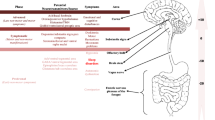Sleep disorders are a well known feature of extrapyramidal disorders such as Parkinson’s disease and Huntington disease. In neuroacanthocytosis (NA), data on the sleep-wake cycle deregulation are limited. Here, we report polysomnographic results for five patients with NA. Although limited by the small number, our results clearly point to a significant impact of the disease on the sleep architecture. Future studies with larger cohort of patients with NA are required to highlight specific sleep disorders features in this disease.
Access this chapter
Tax calculation will be finalised at checkout
Purchases are for personal use only
Preview
Unable to display preview. Download preview PDF.
Similar content being viewed by others
References
Arnulf I (2006) Sleep and wakefulness disturbances in Parkinson’s disease. J Neural Transm Suppl (70):357–360.
Benarroch EE, Schmeichel AM et al. (2007) Depletion of putative chemosensitive respiratory neurons in the ventral medullary surface in multiple system atrophy. Brain 130(Pt 2):469–475.
Diederich NJ, Vaillant M et al. (2005) A case-control study in 49 patients. Sleep apnea syndrome in Parkinson’s disease. Mov Disord 20(11):1413–1418.
Ghorayeb I, Bioulac et al. (2005) Sleep disorders in multiple system atrophy. J Neural Transm 112(12):1669–1675.
Ghorayeb I, Yekhlef F et al. (2002) Sleep disorders and their determinants in multiple system atrophy. J Neurol Neurosurg Psychiatry 72(6):798–800.
Hansotia P, Wall R et al. (1985) Sleep disturbances and severity of Huntington’s disease. Neurology 35(11):1672–1674.
Hardie RJ, Efthimiou J et al. (1986) Respiration and sleep in Parkinson’s disease. J Neurol Neurosurg Psychiatry 49(11):1326.
Hardie RJ, Pullon HW et al. (1991) Neuroacanthocytosis. A clinical, haematological and pathological study of 19 cases. Brain 114(Pt 1A):13–49.
Henkel K, Danek A et al. (2006) Head of the caudate nucleus is most vulnerable in chorea-acanthocytosis: a voxel-based morphometry study. Mov Disord 21(10):1728–1731.
Hori A, Kazukawa S et al. (1985) Electroencephalographic findings in neuroacanthocytosis. Electroencephalogr Clin Neurophysiol 61(5):342–348.
Kartsounis LD, Hardie RJ (1996) The pattern of cognitive impairments in neuroacanthocytosis. A frontosubcortical dementia. Arch Neurol 53(1):77–80.
Kutcher JS, Kahn MJ, et al. (1999) Neuroacanthocytosis masquerading as Huntington’s disease: CT/MRI findings. J Neuroimaging 9(3):187–189.
Rechtschaffen A, Kales A (1968) A manual of standardized terminology, techniques and scoring for sleep stages of human subjects. National Institute of Health Publications, Washington.
Silvestri R, Raffaele M et al. (1995) Sleep features in Tourette’s syndrome, neuroacanthocytosis and Huntington’s chorea. Neurophysiol Clin 25(2):66–77.
Simmons JT, Pastakia B et al. (1986) Magnetic resonance imaging in Huntington disease. AJNR Am J Neuroradiol 7(1):25–28.
Walker RH, Jung HH et al. (2007) Neurologic phenotypes associated with acanthocytosis. Neurology 68(2):92–98.
Wiegand M, Moller AA et al. (1991) Nocturnal sleep in Huntington’s disease. J Neurol 238(4):203–208.
Author information
Authors and Affiliations
Editor information
Editors and Affiliations
Rights and permissions
Copyright information
© 2008 Springer-Verlag Berlin Heidelberg
About this chapter
Cite this chapter
Ghorayeb, I., Dolenc-Grošelj, L., Kobal, J., Pollmächer, T., Danek, A., Tison, F. (2008). Sleep Disorders in Neuroacanthocytosis. In: Walker, R.H., Saiki, S., Danek, A. (eds) Neuroacanthocytosis Syndromes II. Springer, Berlin, Heidelberg. https://doi.org/10.1007/978-3-540-71693-8_21
Download citation
DOI: https://doi.org/10.1007/978-3-540-71693-8_21
Publisher Name: Springer, Berlin, Heidelberg
Print ISBN: 978-3-540-71692-1
Online ISBN: 978-3-540-71693-8
eBook Packages: Biomedical and Life SciencesBiomedical and Life Sciences (R0)



